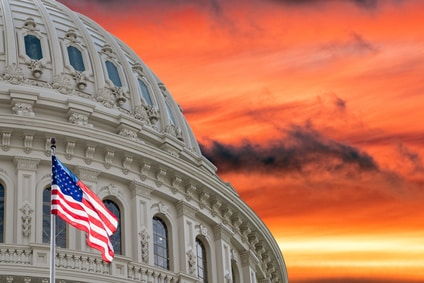09 Sep2019
By Jane E. West
This blog post is written by AACTE consultant Jane West and is intended to provide update information. The views expressed in this post do not necessarily reflect the views of AACTE.
Money, Money Money … Follow the Money … to a Shutdown?
Congress does not officially reconvene until Monday, September 9. They return to the challenge of funding the government before the end of the Fiscal year, September 30. This means that in 13 legislative days the Senate would have to pass 12 separate funding bills, conference each one with the House and then secure President Trump’s signature on each one. What are the odds of that happening? Well, I’m not really a betting person, but I’d say “zero.”
The House left town in August having passed its funding bills, including a very generous one for
05 Aug2019
By Jane E. West

This blog post is written by AACTE consultant Jane West and is intended to provide update information. The views expressed in this post do not necessarily reflect the views of AACTE.
The Senate left town yesterday following on the heels of the House bringing the five-week summer recess into full bloom. Congress will reconvene in September, and thanks to the passage of the budget deal, move forward in adopting 12 appropriations bills, including one with education spending. However, obstacles remain.
29 Jul2019
By Jane E. West
This blog post is written by AACTE consultant Jane West and is intended to provide update information. The views expressed in this post do not necessarily reflect the views of AACTE.
Congress is heading out of town—the House leaving today for a six-week recess and the Senate leaving at the end of next week. With the amazing budget deal headed for the finish line, September promises to be full of appropriations bills, including the education funding bill we’ve all been waiting for.

Unbelievable: Congress and the White House Make a Deal on 2 Year Budget Caps and Debt Ceiling
In a stunning proactive bipartisan move, the Congress and the White House have agreed to a two-year budget deal. This frees up all lawmakers and the president to focus on the 2020 elections without the threat of a government shutdown. Key features of the deal include the following:
15 Jul2019
By Jane E. West

Congress came back to Washington this week with a boatload of work to do in the short few weeks before the next recess, in August. It could be a long hot summer.
First up: Budget and Funding
When Congress left for July 4 recess, the House had passed almost all of the 12 required funding bills and the Senate had not begun with any of the 12 bills. September 30 marks the end of the fiscal year; without the new spending bills signed into law, a government shutdown will be in the offing. With Congress scheduled to be in recess most of August, the pressure is on.
The holdup is the budget—or the overall spending cap, which the House, the Senate, and the White House must agree to pass. While the House adopted its own budget caps, they are higher than those that the Senate or the White House will accept. Added to the mix is the pending need to raise the debt ceiling (this is the borrowing limit for the federal government, which routinely needs to be raised to avoid default). Thus, the pressure is on from three corners: budget, FY 2020 funding bills, and debt ceiling. These three dire needs are in the mix together and there is an effort to wrap their resolution into one package—possibly before the August recess. Learn more.
Senate Confirms New Higher Education Leader for Department of Education
01 Jul2019
By Jane E. West
This blog post is written by AACTE consultant Jane West and is intended to provide update information. The views expressed in this post do not necessarily reflect the views of AACTE.
Congress is headed out of town today for the week-long July 4 recess next week. Check your local July 4 parades and picnics—Members of Congress often show up there and it is a great time to connect with them!
What Can we Expect When Congress Returns July 8?
- Congressional Schedule
The Congress returns July 8 for about four weeks. Then they head into the August recess. They will be back for about four weeks in September. This equals about 27 legislative days left before the October 1 beginning of the FY 2020 fiscal year. Conventional wisdom holds that the closer we get to being all consumed by the next election, the less Congress will get done. Time is short, but there are always surprises!
- Appropriations
Once again, we may be facing a government shutdown in October. Before that time all 12 appropriations bills must be completed, and some action on the debt ceiling must be taken. (The debt ceiling is when the government is about to exceed its borrowing authority and thus, must increase the amount it can borrow, in order for the government to continue to function.) This is a tall order with only 27 legislative days.
- Higher Education Act
The Senate HELP Committee has been working for months on a bipartisan bill to reauthorize the Higher Education Act. Yet the long-awaited draft has yet to materialize. The big hold up appears to be how colleges and universities should respond to allegations of sexual assault on campus—a provision housed in Title IX of federal civil rights law. In fact, HELP Committee Chair Lamar Alexander (R-TN) and ranking member Patty Murray (D-WA) asked a bipartisan group of six senators to meet to try to resolve this issue.
What Should We be Watching in the Federal Agencies?
23 Jun2019
By Jane E. West
This blog post is written by AACTE consultant Jane West and is intended to provide update information. The views expressed in this post do not necessarily reflect the views of AACTE.
Today makes summer official! The House has certainly given us something to celebrate!
-
- Massive Spending Bill Passes House with Large Increases for Education!
Education advocates are taking a moment to rejoice in a funding bill (H.R. 2740) that passed the House this week (with a vote count of 226-223) calling for a record high level of spending for the Department of Education bringing total investments to $75.9 billion. Big winners in the bill include Title I, special education and social emotional learning. Notably, the bill cuts funding for charter schools by 10%.
The rejoicing is tinged with the knowledge that this is as good as it will get for education spending. Unfortunately, the Senate will not have numbers this high, as the budget caps, which are yet to be determined, will undoubtedly require lower figures. And the Trump Administration has indicated that it would veto this bill.
The focus now turns to the Senate where Appropriations chair Sen. Richard Shelby (R-AL) has indicated that they will begin moving bills in July. But that pesky budget deal lurks around the corner.
See the CEF charts on individual education program funding.
17 Jun2019
By Jane E. West
This blog post is written by AACTE consultant Jane West and is intended to provide update information. The views expressed in this post do not necessarily reflect the views of AACTE.
I started last week in NYC visiting a fabulous early childhood program called Beekman House in the south Bronx. They have a partnership with Bank Street College. I was once again rendered speechless (hard to do) by the incredible teaching I saw. It made me want a do-over for pre-k! This is part of EdPrepLab— a new initiative by Learning Policy Institute. Check out the Ed Prep Matters blog article to learn more. Shout out to AACTE for giving me this opportunity!
- House Completes Portion of Massive Spending Bill … To Be Continued Next Week
Members of the House hightailed it out of town Thursday leaving a portion of the $982 billion spending bill completed—but more to come next week. The portion of the bill completed is the Labor/HHS/Education part of which includes $75.9 billion for the Department of Education. The House was in session all night Wednesday, finally adjourning at 4:00 a.m. on Thursday only to return again later Thursday morning.
Rep. Rosa DeLauro (D-CT) wins the prize for no sleep, as she was there shepherding her bill through every minute of the process and the over 100 amendments offered. She reported getting only an hour of sleep noting “You know, you’re so wired!”
10 Jun2019
By Jane E. West
This blog post is written by AACTE consultant Jane West and is intended to provide update information. The views expressed in this post do not necessarily reflect the views of AACTE.
After a 10-day Memorial Day recess, Congress returned for a brief three-day session and then hit the road again. They will roar back into town next week with a plate full of funding issues to address.
- Budget and Appropriations: House on the Move!
The House
Democrats are vigorously exercising their hard-won majority in the House by moving rapidly on spending bills for FY 2020. By early next week all 12 appropriations bills will have moved through Committee markups and be ready to go to the House floor. House leadership has announced its intent to see all 12 bills passed by the end of June!
20 May2019
By Jane E. West
This blog post is written by AACTE consultant Jane West and is intended to provide update information. The views expressed in this post do not necessarily reflect the views of AACTE.
Today marks the 65th Anniversary of the Brown vs. Board of Education Supreme Court landmark decision that established the principle that separate is not equal. How far have we come? Much to contemplate here. You will see below that a House education panel spoke loud and clear on that topic: we have a long way to go.
- Trump Proposes Taking More Funds from Pell Grants – to Fund Moonshot? Huh?
This week President Trump submitted to Congress some revisions to his original budget request. Notably, he took back the proposed cut he originally made for Special Olympics (after great bipartisan outrage); but he also added a new cut in the form of an additional $1.9 billion to the Pell grant surplus. It appears that the Pell cut would go toward funding the President’s proposed 2024 NASA moonshot! Education advocates were outraged. As Jon Fansmith of the American Council on Education put it: “Do I want to make college more expensive to fund space travel to the moon and Mars?” Hmmmm …
The President had already requested a $2 billion cut in Pell funding. So the total $3.9 billion recission would result in the Pell surplus being exhausted by 2022! This request is likely to be ignored on Capitol Hill, as no one—Republican or Democrat—ever really contemplated cutting Special Olympics. And while the Pell Surplus has been modestly raided in the past, a $3.9 billion cut is highly unlikely.
12 May2019
By Jane E. West
This blog post is written by AACTE consultant Jane West and is intended to provide update information. The views expressed in this post do not necessarily reflect the views of AACTE.
I’m downright excited to have some GREAT news to report from Washington! Some of our leaders want to increase the federal INVESTMENT in public education! Hallelujah.
- House Moves Expansive Education Funding Bill through 8 Hour Marathon Mark up
This week Chair of the House Subcommittee on Labor/HHS/Education Rosa DeLauro (D-CT) successfully moved her spending bill out of the full Appropriations Committee. The bill retains its overall 6% increase for education from last fiscal year, bringing the Department of Education to $75.9 Billion, and features significant increases for key education programs.
08 May2019
By Jane E. West
This blog post is written by AACTE consultant Jane West and is intended to provide update information. The views expressed in this post do not necessarily reflect the views of AACTE. To view the full blog, visit janewestconsulting.com.
Congress is back from a two-week recess and education saw a lot of action this week!
- House Subcommittee Marks Up FY 2020 Funding Bill with a 6% Increase for Education!
This week, Rep. Rosa DeLauro (D-CT) began the FY 2020 appropriations process by moving the Labor/HHS and Education bill through the subcommittee. Her first bill as chair of the subcommittee reveals an impressive high-water mark for education spending, raising the federal investment by 6% over last year. Lead Republican on the subcommittee, Rep. Tom Cole (R-OK), noted that he does not think the large increases in the bill will be supported by the Senate or the president and that at best, this disagreement will lead to a year-long continuing resolution or at worst, another government shutdown. Nonetheless, the bill was passed out of subcommittee and will likely be marked up by the full House Committee on Appropriations next week.
12 Apr2019
By Jane E. West
This blog post is written by AACTE consultant Jane West and is intended to provide update information. The views expressed in this post do not necessarily reflect the views of AACTE.
Congress was busy this week trying to wrap a few things up as they enter an extended recess period. With the timeline for the election pressing, the momentum will continue. Remember the first Democratic presidential candidate debate is in June—just two months away! So the pressure is on.
- House Makes Magic Move on Budget!
The Budget Control Act, as it stands now, would require dramatic cuts for education and other programs for FY 2020, which begins October 1. In order to avoid significant cuts to education and other programs, the Budget Control Act needs to be amended to increase the spending caps. While the House Budget Committee adopted new spending caps this week, Democrats were unable to find consensus and bring that provision to the House floor.
But do not despair! Where there is a will there is a way! On Wednesday the House adopted something called a “deeming resolution” which provides for $1.3 trillion for the 12 spending bills in FY 2020. The “non-defense discretionary” portion (which includes education) will be $34 billion over the FY 2019 spending level. This deeming resolution paves the way for Appropriations Chair, Rep. Nita Lowey (D-NY), to divvy up the funding into 12 pots—one for each of the appropriations bills.
16 Oct2017
By Jane E. West
The American Council on Education, the major coordinating association for our nation’s colleges and universities, is leading the Protect Dreamers Higher Education Coalition, of which AACTE is a member. The coalition is coordinating a week of advocacy efforts beginning today, October 16, and has developed a website providing multiple resources related to Dreamers, including fact sheets and talking points, which can be used by individual campuses for advocacy.
In addition, the coalition is leading a letter that your institution can sign on to – but time is tight. The deadline is Wednesday, October 18, at noon EDT. To have your institution sign on to the letter, please reach out to your president’s office as well as your government relations staff. Find the instructions here.
05 Oct2017
By Jane E. West

The Learning Policy Institute (LPI) is out with a new analysis of teacher turnover and its impact on teacher shortages, showing that the nationwide shortfall of 100,000 teachers predicted in last year’s study A Coming Crisis in Teaching? has largely been realized and issuing recommendations to stem the problem before it grows worse.
In the updated report – Teacher Turnover: Why It Matters and What We Can Do About It – Desiree Carver-Thomas and Linda Darling-Hammond share recent data revealing that in just 31 states, 82,000 positions are filled by underqualified teachers and at least 5,000 are unfilled altogether; extrapolated to all states, the total number is likely around 110,000. If current trends persist, they say, we could face an even higher shortfall next year. The shortages are most acute in the fields of special education and science, technology, engineering, and math (STEM) and are disproportionately present in high-poverty and high-minority schools.
19 Jan2016
By Jane E. West
Editor’s Note: This briefing has been postponed due to weather challenges. Please stay tuned for an announcement of the new date.
On Wednesday, January 27, the National Network of State Teachers of the Year (NNSTOY) will hold a congressional briefing to release its new study Teacher Advancement Initiatives: Lessons Learned From Eight Case Studies. Completed in conjunction with Pearson, the report is the product of a 3-year study of schools and districts with established career advancement initiatives. The study identifies components of successful, sustainable teacher career continuums with positive impacts on teacher recruitment, retention, and job satisfaction.
The eight case studies include schools and districts in urban and rural areas of Arizona, California, Colorado, the District of Columbia, Iowa, North Carolina, Tennessee, and Washington. The report identifies key elements of effective career continuums such as structured roles for teacher leaders, opportunities for release time and collaboration, compensation differentiation, peer coaching and evaluation, embedded professional development, and structured opportunities for teacher voice in decision making.










